What does rot on strawberries look like and how to deal with it?
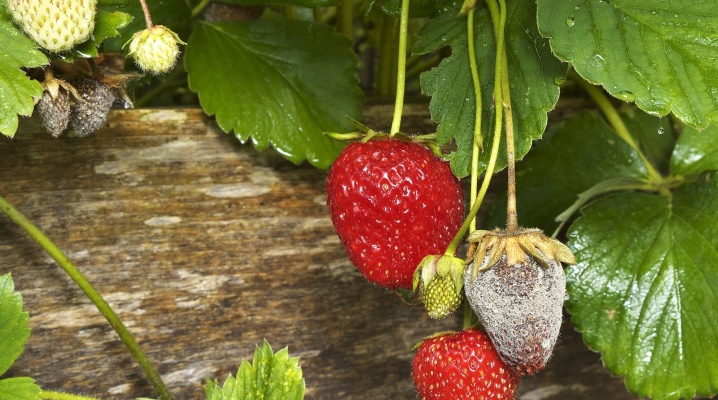
White, gray and black rot on strawberries is quite common; measures to combat it have to be applied during fruiting and after harvest. Properly organized prevention can protect plants, but it does not give 100% guarantees - sometimes it turns out to be easier to plant disease-resistant varieties. If signs of root rot and damage to berries are detected, you will have to use special preparations for processing.
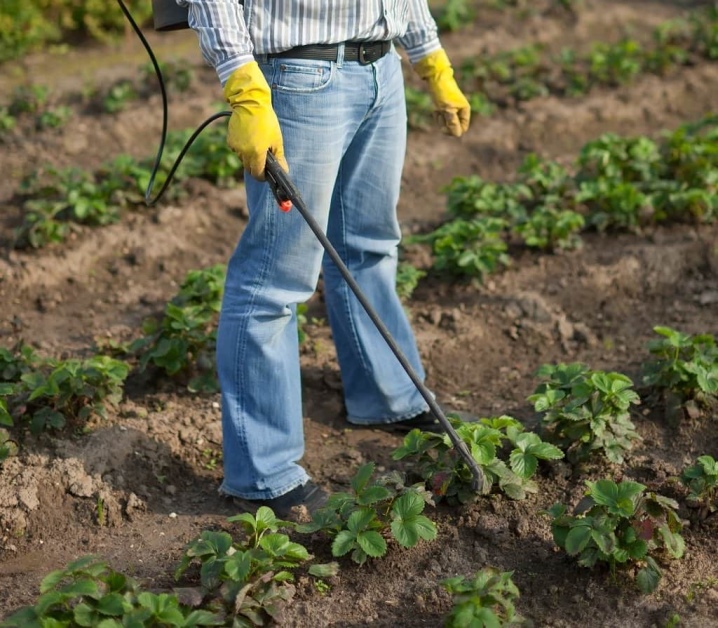
Description of species
The signs of rot on strawberries are hard to miss. With a lesion on the berries, a specific plaque appears, the signs of the disease become more and more pronounced over time. Strawberries look unappetizing, ripen worse, and should not be eaten. It is worth talking in more detail about what types of this defeat exist.
- White rot. Its sign is the appearance of a specific light fluff on the surface of the fruit. Underneath are traces of rot. The leaves become pale, dry out, and begin to die off when the humidity rises. You cannot eat berries.
- Gray rot. With this disease, the entire bush is covered with fluff of a specific graphite shade; when touched, it releases fungal spores. Fruits change their shape, leaves and ovaries dry out. In the absence of help, the plant dies quickly.
- Black rot. It manifests itself as a brown strawberry fruit. The berries themselves become watery, covered with a colorless bloom, which turns black over time.
- Late blight leathery rot. When affected by this disease, the plant develops specific brown spots on the fruits: dark on ripe and light on green. The stems gradually acquire a brown tint, die off. Inside, the berries become coarser and have a bitter taste.
- Root rot or rhizoctonia. Strawberries stop growing underground shoots. The bush gradually turns black, its individual parts die off. The leaves at the bottom of the plant take on a brown tint.
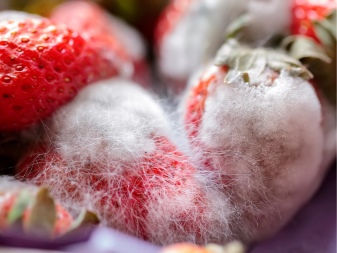

Whatever the source of the disease, any damage to the fruits and roots is a serious danger. Any changes cannot be ignored, otherwise you can be left without a crop, as well as put other crops at risk of contamination.
Causes of occurrence
The main source of any type of rot on strawberries is fungus. Each type of disease has its own pathogen. For example, leathery rot caused by Phytophthora cactorum - a mushroom that actively reproduces at an ambient temperature of +10 to +25 degrees in conditions of high humidity. It poses the main danger in the spring and autumn periods.
Root rot is caused by another infectious agent, the fungus Rhizopus nigricans Ehrend. It affects damaged berries, is most active in extreme heat. The fungus is highly contactable, can be carried on shoes and garden tools, and enter the soil with water. Its distribution routes also affect the air environment, and sometimes insects are the source of infection.
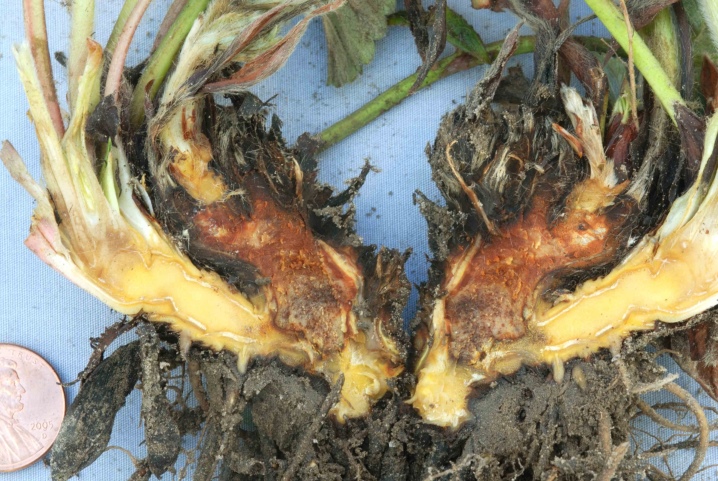
Gray rot on strawberries occurs in spring and summer, during periods of high humidity. The spores of the fungus Botrytis cinerea Pers are carried through the air, they can get on the berries with drops of water during irrigation or precipitation. Seasons with heavy rains are especially dangerous.
Some fungal diseases develop only when the gardener himself creates favorable conditions for this. For example, white rot is caused by Whetzelinia sclerotiorum. It manifests itself with too abundant watering, overcrowding of plantings.
Plants are affected during the ripening period of the crop.
Control measures
There are certain rules to deal with strawberry rot quickly and efficiently. All drugs that can be used to process a garden berry, if it is sick, are divided into biological and chemical. The first group helps to fight the fungus during the fruiting period, it does not pose a danger to the taste of the fruit, it is devoid of a cumulative effect. It is possible to get rid of rot after harvesting with chemical preparations based on sulfur, copper sulfate. These shrub treatments and treatments are tougher, but prevent re-infestation.
Treatment with biological agents can be done when ovaries appear, in the presence of berries. It is customary to treat strawberries by surface application of the drug. With root rot, you will have to water it at the base. In all other cases, it will be enough to spray the bushes. Repeated treatments may be required to save the plants.
The ways to get rid of rot on strawberries are quite varied.
You can also cope with the first manifestations of the disease with folk remedies. These include watering the root zone with a strong solution of potassium permanganate. After that, you should additionally use "Fitosporin" to restore useful microflora.
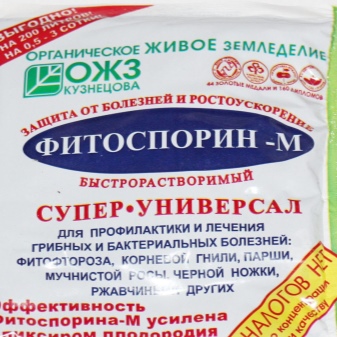

During fruiting
During the fruiting period, you cannot use drugs that accumulate in berries for a long time. Here biological preparations will be more effective, destroying pathogenic microorganisms, replacing them with useful microflora. With their help, it is possible to provide full protection of plants without harming their taste. Biologics that are effective against different types of rot are well known to many gardeners.
These include the following compositions.
- Fitosporin. Microbiological drug that works immediately from the moment of application. On sale it is presented in the form of a water-soluble suspension, powder or paste. The agent suppresses the development of pathogenic microflora, is not toxic, retains its properties when frozen and heated. The fruits are completely safe to eat even on the day of processing.
- "Integral". A biological product suitable for treating bushes during the growing season. The composition includes humate, beneficial microorganisms. The tool does not affect the taste, the ripening time of the fruit.
- "Sporobacterin vegetation". The product contains spores of beneficial microorganisms, is available in a 10 g package, which is enough for the rehabilitation of 200 bushes. Suitable for prophylactic treatment and treatment of fungal diseases.
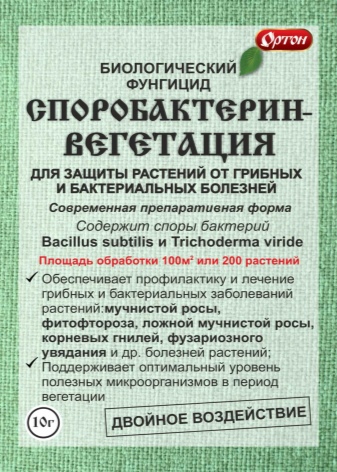
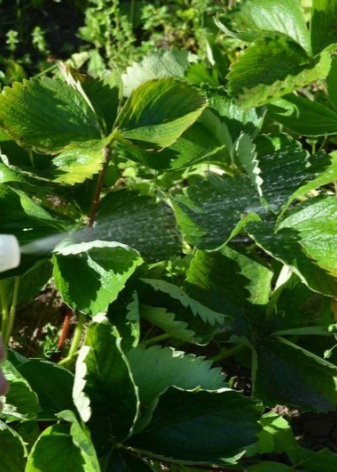
Also against certain types of rot, preparations such as "Trichodermin", "Trichoderma", "Trichophyte", containing a common active ingredient, are effective. They can be produced in suspension, powder or tablet form.
After harvest
Among the funds that should be used in early spring or late autumn, after harvest, the following chemicals can be distinguished.
- Teldor. It is applied by spraying with the prepared solution, forms a film on the surface of the sheet plate. The protective effect lasts for 14 days even with heavy rainfall. Three times processing is shown during the season: during the formation of the rosette, after budding and at the end of the harvest.
- Horus. Long-lasting fungicidal preparation, it cannot be used at the stage of ovary formation. The chemical is effective even in cold weather, suitable for early spring and late autumn processing.
- Bordeaux mixture. It is applied at a concentration of 3% at the end of the fruiting period or before flowering.


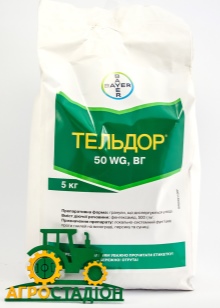
Not all types of rot can be successfully removed. Root damage requires the complete destruction of the plantings. The bushes are burned.The remaining space is disinfected with a strong solution of potassium permanganate. It is recommended to re-process it in the spring.
Prophylaxis
You can save strawberry bushes from damage by different types of rot if you follow certain recommendations. Regular transplanting will help protect the plants. Its timing and frequency are determined exclusively by the variety. Do not plant strawberries in the ground where potatoes used to grow.
Basic preventive measures.
- Maintaining a sufficient distance between landings.
- Good ventilation and illumination of plants.
- Mulching the soil under varieties with a low fruit position.
- Use black sheeting or linen to maintain planting frequency.
- Follow the recommendations for the frequency of watering for a particular variety.
- Timely removal of weeds.
- Periodic inspection of bushes, removal of affected shoots, leaves, berries.
- Careful selection of planting material.
- Feeding plants with manganese in the root zone, reducing the volume of organic and nitrogen fertilizers.
- Mowing green mass in autumn. Such measures will get rid of diseases and parasites. It is recommended to mow in early autumn, so that the plant has time to recover before the first snow.
In the case of root rot, the main preventive measure is preliminary tillage. "Trichodermin" or "Gamair" will help to destroy the spores of mushrooms.
In addition, it will be useful to check the seedlings before planting in the ground. It is important to inspect the root system of plants when buying to make sure it is healthy and well developed.
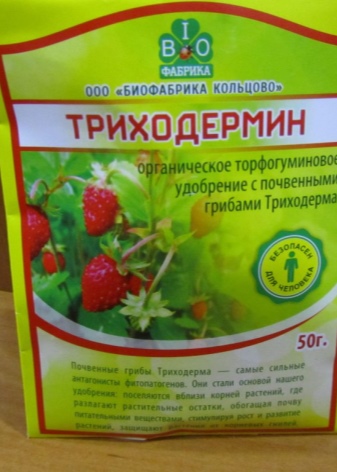
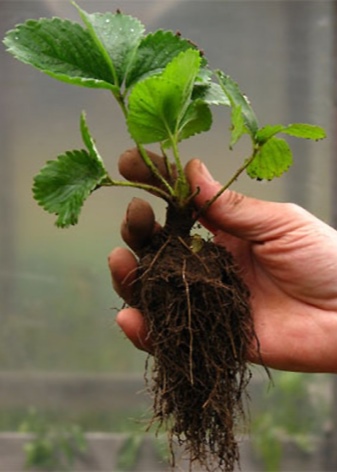
Resistant varieties
There are a number of fungal resistant strawberry varieties. Among them are the following.
- Talka. Variety oriented to planting in the Black Earth Region and the Central Region. Fruits in medium-sized berries, ripens early, and provides high yields.
- "Early dense". A popular variety of the Crimean selection. Differs in good productivity, ripens early, resistant to many diseases.
- "Leningrad Late". A variety with a long history of successful cultivation in the North-West of Russia. The variety is moisture-loving, with large berries, bears fruit abundantly.
- "Elvira". Variety of Dutch origin, characterized by early fruiting. Suitable for growing in conditions of short daylight hours.
- "Wonderful". A productive variety with an oblong berry shape, bred in the USSR. Unpretentious, can be grown in a greenhouse or open field, the bushes are tall, with powerful peduncles, capable of self-pollination.
- "Geneva". A remontant variety bred by American breeders. Differs in abundant and long-term fruiting, small bushes height. When growing, soil mulching is required. The mass of berries reaches 50 g.
- "Festival Chamomile". A variety bred in 1992. It is characterized by a bush up to 20 cm in size with a dense leafy head and up to 15 peduncles. The shoots are powerful, well developed, do not bend under the weight of the berries. The fruits are large, can reach a weight of 40 g.

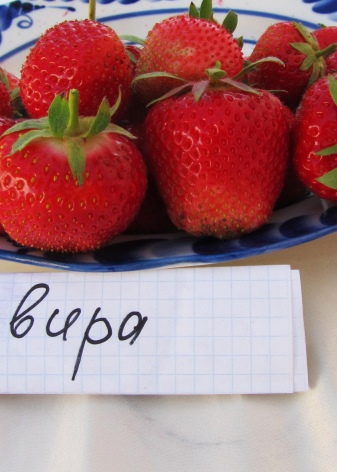
The correct selection of strawberry varieties is especially important when growing in humid regions. It is here that fungal diseases of plants develop especially actively.
The following video will tell you about what gray rot on strawberries is and how to deal with it.













The comment was sent successfully.